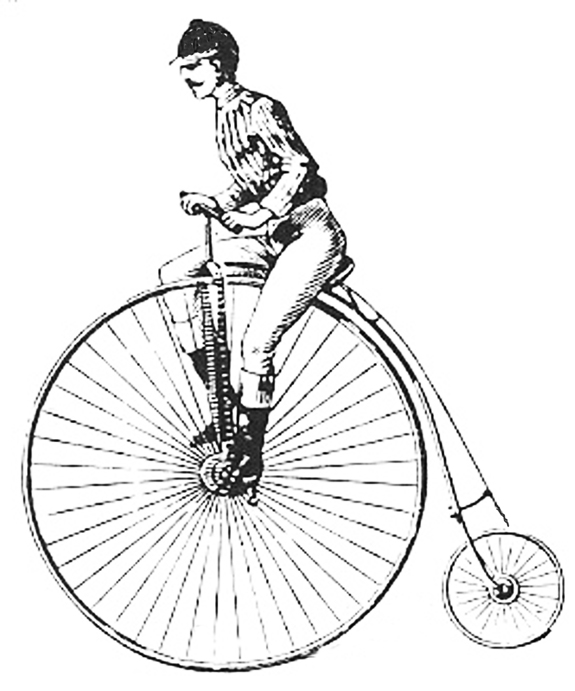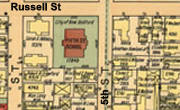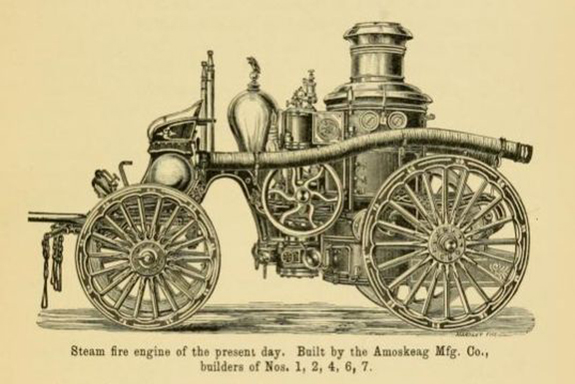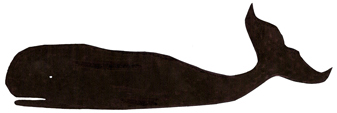Local New Bedford, Ma. History
1860 - 1869 In Chronological Order
|
 |
The Velocipede was all the rage over the country and
in 1869
New Bedford caught the fever |
| |
1860
New Bedford Copper built a location on the waterfront to supply ships with copper hull sheathing etc.
It eventually became Revere Copper and Brass.
As of current times the copper sediments in the river bottom at that location are extraordinarily high. |
| |
1860
Acushnet broke away from Fairhaven. |
| |
1861
April 16,
Four days after the attack on Fort Sumter, The New Bedford Guards, Company L, Third Regiment Massachusetts Volunteer Infantry, stood in line in front of city hall to receive the tributes of praise from an eloquent speaker and an ovation from an immense throng of citizens.
After much ado, on the 17th they joined their regiment and passed in review at the State House.
The next morning they departed on the steam frigate "Pawnee." |
| |
1861
The federal government purchased 45 old vessels, principally whalers and loaded them with stone and sank them in the channels of Charleston and Savannah, important ports to the Southern Confederacy.
This was known as "The Stone Fleet." |

The Fifth Street School in New Bedford, Massachusetts was said to be the first school in America to fly the American flag every day starting on May 11, 1861.
Over the years if fell to different people to continue the job of putting up the flag.
In 1871 Betsy B Winslow was a teacher there at a salary of $525.00 a year.
It was located on the South-West corner of Russell and Fifth St.
(Fifth Street is now called Pleasant Street)
On the corner of
Pleasant and Russell Streets, there is a square is dedicated to Sunshine Ramos (Antonio Francisco Ramos) who lived from 1884 until 1970.
For many years, he was responsible for putting up the American Flag at the Fifth Street School.
Read more and see photos about the Fifth Street School and Antonio "Sunshine" Ramos
|
| |
1861
The Kirby Paint company is established on Pine street as the George Kirby Jr. & Co.
Of that company, the current Kirby Paint company exists today. |
| |
1861 April 16
Postmaster Cyrus W. Chapman was appointed postmaster and inaugurated the Free Delivery Service for mail. |
| |
1861
Morse Twist Drill
Conflicting information about the inventor of the Twist Drill.
His name was Stephen A. Morse, and the patent is in his name Stephen Ambrose Morse, but the old New Bedford Board of trade said the name was Samuel A. Morse.
They may have been confused with the Morse Code inventor Samuel Finley Breese Morse (April 27, 1791 – April 2, 1872) born in Charlestown, Ma.
In any event,
Mr. Stephen Morse came from East Bridgewater, Ma. and developed a drill that had a straight edge rather than the usual concave cutting edge, which was prone to break at the point. In 1863, he obtained a patent for his new drill.
In 1864, he set up a shop in New Bedford, which eventually became, Morse Cutting Tools.
This business provided a lot of jobs for many local people.
By 1872, the popularity of the drill had spread all over the U.S. and overseas. See the catalogue
The company closed in 1990.
The Morse Cutting Tools brick mill building stood until the mill was demolished in 1997.. |
| |
1863, April 18
An act was passed for supplying the city with pure water.
It provided for appointment of commissioners and gave the power to take land and water and water rights for the purpose.
On April 14, 1864, it was accepted by the city. |
| |
1863
"
Men of color" numbering about 52 joined the 54th and 55th regiments several others joined the US Navy and the 5th calvary. Recruiting was done on the corner of William Street and Acushnet Avenue. $25.00 was given to each family of those men who were recruited by a committee.
On March 4th 54 of the men were given a pair of mittens before taking the train to Fort Meigs at Readville.
(Just south west of Boston)
New Bedford's Ladies Soldiers Relief Society sent shirts, stockings, sewing kits and handkerchiefs to them while they were in camp. Others from the city sent tobacco, apples, towels, shoe black, brushes, etc. |
| |
1863
July 18 Sergeant William Carney, an African American soldier of the 54th regiment (an all African-American regiment) was born on March 28, 1842 in Norfolk, Virginia.
Along with his father he slipped the bonds of slavery and moved to New Bedford, Ma. at an early age.
Sergeant William Carney became the first African American to distinguish himself in battle so as to be later awarded the Medal of Honor for "most distinguished gallantry in action" during the assault on Fort Wagner, South Carolina, on July 18, 1863.
During the assault on the fort, he had been shot in the thigh.
He crawled uphill on his knees, bearing the Union flag while he was urging his troops to follow.
He was shot several more times and incredibly managed to hold the flag off of the ground.
His action was the first by an African-American to deserve the Medal of Honor although others that had received theirs were for actions that happened after Sgt. Carney's act of heroism.
Carney was finally awarded the Medal of Honor on May 23, 1900
The quote he is remembered by is this:"Boys, I only did my duty; the old flag never touched the ground!"
He retired as a letter carrier for the post office in 1901. |
| |
1864
Despite the war being on the city celebrated the 200th anniversary of the incorporation of the town of Dartmouth.
New Bedford, Fairhaven, Dartmouth, Acushnet and Westport were all involved.
There were public orators and brass bands and singing and processions through the streets. |
| |
1865
The Civil War ended, and New Bedford soldiers came home.
During the war years the Confederate cruisers destroyed several whaling ships.
New Bedford supplied about 2,000 men for the Union Armies and 1,336, for the Navy.
Abraham Lincoln Signed the "Emancipation Proclamation", freeing all of the slaves in the USA.
The old underground railroad was no longer needed. |
| |
| 1866
The Wamsutta Club. Charles Warren Clifford organized it originally as an athletic club.. The purpose was to play a new form of baseball.
It eventually became a social club and moved to several different locations before settling in at the corner of County and Union streets.
It was first built in 1821 by James Arnold. He died and then after his wife died in 1919 the Wamsutta Club purchased the Arnold Mansion.
Two additional wings on the north and south increased the size of the building and squash courts were added on the west side, in a new basement addition. |
| |
1866
April 1
Tin mailboxes were placed on streets for mail pick-up by one of the five postal carriers.
Previously there had been wooden boxes placed for mail in a few stores in the city.
In 1867 iron mailboxes replaced the tin ones. |
| |
1866 July 4th,
The imposing" Soldiers and Sailors" monument in the Common Park was dedicated. It still stands today in the middle of the Common Park, since the late 1900's it has been also known as Clasky Park. |
| |
1867
At 4 o'clock on September 4th one of the members of a firm was demonstrating the non-explosive qualities of the oil that was manufactured by that company.
He threw a match into a 100 gallon tank of oil and it caught fire spreading to 8 other tanks of equal capacity.
At 9 o'clock, there was a horrendous explosion and the oil fire was moving towards tanks of petroleum.
The steady work of firemen held the flames back and kept the fire from becoming a terrible disaster.
The steam fire engines worked for 8 hours, and the fire was a loss of $10,000.00 with no insurance. |
| |
1867
On the site of the current New Bedford High School and Keith Middle School and athletic fields, brothers, Jacob and Benjamin Howard, together with some other New Bedford residents bought 25 acres of land on Parker Street, west of Oak Grove Cemetery.
They planned to erect buildings and machinery to manufacture peat from the bog on site.
This later became the site of the notoriously toxic Parker Street Dump. |
| |
| 1867
The Young Men's Christian Association (YMCA) was organized here. The first building was built during 1891.
It was demolished 1975 and is now a parking lot situated on the northwest corner of Sixth and William Streets. It had been the first facility specifically for a YMCA in the USA.
The Seamans Bethel was rebuilt after a fire. |
| |
1868
The Howard Brothers peat harvesting operation on Parker street and west of Oak Grove cemetery is ceased and the land devoted to gardening with one acre of it for a cranberry bog. |
| |
1868
Charles Dickens visited the city and gave a reading of "Trial of Barbell vs. Pickwick" the hall was crowded, and all were delighted. |
| |
1869
The New Bedford water works had been being built since 1864 and finally in the last weeks of 1869 came to life and water flowed -the city water system was established.
This enabled the manufacturing mills to flourish.
The first reservoir was a dam in the fresh water source, in the northern reaches of the Acushnet river. The dam failed at first.
Eventually, the system got online with a McAlpine Steam pump forcing water through the pipes that were laid to feed fire hydrants and homes and businesses.
There was a main reservoir east of the train tracks between Coggeshall, Bowditch and Cedar Grove Streets. A distribution reservoir was up on the highest point between Mt. Pleasant and Highland St.
The first use of a fire hydrant was on December 20, 1869, to extinguish a house fire at 21 School St.
This water source and storage was the arrangement, until the water works acquired Quitacas pond in 1899. |
| |
1869 April
The New Bedford Chorale Association was organized and it began rehearsals in City hall for the substantial Peace Jubilee to be held in Boston, the following June.. |
| |
1869 September 8th
A Terrible gale, hit the city and destroyed much of the shipping in the harbor, knocked down trees and damaged the spires of churches etc. The Fairhaven - New Bedford Bridge was destroyed.
One good thing was the purchase of the bridge franchise for $20, 970.31 and the building of a new structure. The new bridge was not a toll bridge and was free to all.
Possibly the first mention of macadam used in the city is here when the Bridge Square formed by a continuation of Front Street, It was macadamized, and the cost including curbing and crossings was $1,107.00 |
| |
1869
Velocipede mania swept over the country and came to New Bedford. A velocipede is a bicycle.
See the photo at the top of the page. |
| |
1869
Rooms at the Northwest Corner of Union and Purchase Street were leased for the use of the YMCA. The organization occupied several different buildings in the area up to the present day. |
| |
 |
This steam fire engine was used in New Bedford |
| |
| |

